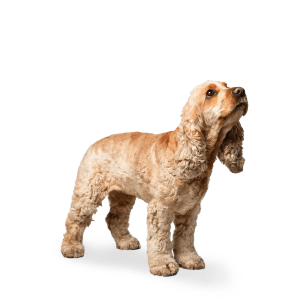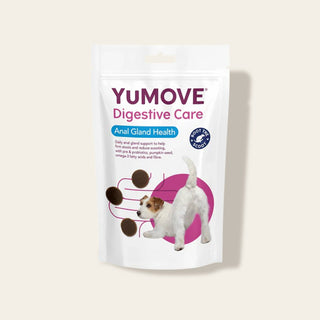

Benefits of fibre for dogs
Fibre for dogs is quite frankly crucial to sustain a healthy gastrointestinal tract and a good quality of life. Fibre has so many important functions in the body, for both people and pets. If our canine friends do not receive enough high fibre foods for dogs, it can lead to health complications such as gut microflora imbalances or anal gland impaction. This is why knowing the health benefits of fibre, and how to add fibre to a dog's diet from a young age, is so important.
The benefits of fibre for dogs
There are two types of fibre, insoluble and soluble. It's important your dog gets a good mix of both types of fibre for dogs, as they both serve different functions. So what is the difference between soluble and insoluble fibre?
Soluble fibre dissolves in water. When soluble fibre is dissolved in water, it becomes an essential food source for the ‘good’ bacteria in your dog's intestines. The ‘good’ bacteria need energy from the soluble fibre to do their job of aiding in digestion, and preventing the overgrowth of ‘bad’ bacteria.
Insoluble fibre on the other hand, does not dissolve, instead it retains its structure and adds volume or bulk to the stool. A healthy stool needs lots of insoluble fibre to pass through the intestinal tract and out the other end in a timely manner. Too little fibre in the diet can slow down the passage of the stool through the gut leading to constipation, or other issues.
Four signs your dog needs more fibre
Dogs can give us clear signals that their diet is lacking in fibre. Their stool tells us a lot about their dietary needs. Using the Dog Poop Chart below we can learn about their internal health.

1. Reduction in faecal volume or shape
Small hard nuggets can indicate a lack of fibre in the diet, and can be painful for your dog to pass. Thin, but sausage shaped stools are slightly better, but still indicate a lack of fibre overall.
2. Reduced stool production
Your dog should defecate 1-2 times a day as a minimum. If they are only passing stools every few days, or you notice a reduction in the amount of times they are toileting, this can be a sure sign of lack of fibre in their diet.
3. Loose stools
Can be a sign of a bacterial imbalance in the gastrointestinal tract, which is a problem fibre can help correct as it is a food source for the ‘good’ bacteria in the gut.
4. Scooting
Another sign, aside from stool production that we commonly see in dogs is they will be scooting their bottom along the ground. This is often a sign of blocked anal glands, which can be related to lack of fibre in the diet
How to add fibre to your dogs diet
Feeding high fibre food for dogs is the easiest way to rapidly increase your dogs daily intake of fibre. There are many different types of high fibre foods for dogs and our favourites are below.
Wheatgerm
Packed full of omega oils, wheatgerm has anti-inflammatory properties, helpful if your dog suffers from a sensitive digestive tract or loose stools. It comes as a powder or supplement and is a type of fibre for dogs that is easy to feed.
Milled flaxseed
It is a good source of soluble fibre for dogs, which is good for gut health. It's a good one to sprinkle onto home made treats, or mixed onto wet food for extra texture when eating.
High fibre vegetables
Pumpkin, kale, broccoli and carrots are all good examples of high fibre foods for dogs, and dogs will usually eat these vegetables willingly if added into meals or fed as treats. Cooked vegetables are better than raw, as your dog can also benefit from the other properties vegetables hold such as vitamins and anti-oxidants.
Kelp
Kelp contains soluble and insoluble fibres, and acts as a prebiotic, making it a great ingredient to look out when adding fibre to dogs diet. The powdered version of kelp is easy to add into the regular meal, and dogs often won't notice any difference in taste. Remember kelp is high in iodine, so avoid giving too much or you can create other health concerns.

YuMOVE’s probiotic and fibre supplements
Sometimes, trying to add extra fibre for dogs' meals can be tough- they may be fussy eaters and dislike the taste of extra vegetables in their meals. So, using a probiotic and fibre supplement can be an easy way around this.
YuMOVEs Probiotic and Fibre supplement is a powder that is easy to hide in meals, and is a source of fibre for dogs glands, reducing the fishy smell or scooting signs we see when they are blocked or full.
Anal gland supplements like our YuMOVE Anal Gland Health Bites are a tasty and convenient option. Many dogs enjoy them as part of their daily routine – ideal for pet owners looking for simplicity. These bites also contain other gut-supporting ingredients, such as prebiotics and fibre, alongside probiotics.
The takeaways
Fibre for dogs is essential for normal stool formation, intestinal and anal gland health. There are two types of fibre, insoluble and soluble that have different health benefits to the gut, and when considering high fibre food for dogs, you need to have both types present.
Whilst probiotics and increased fibre can lead to improved health, there are some conditions that cannot be fixed by diet alterations alone, and need medical assistance. If you are concerned about your dog's stools, anal glands or overall health your veterinarian is always on hand to help so reach out if concerned.
If you are wondering what other ways there are to give probiotics, you may find these articles helpful to find the easiest way to improve your dog's digestive health.





